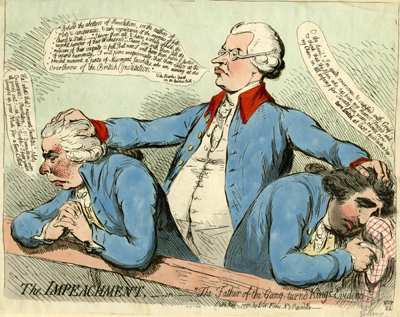The Impeachment. . .
The Impeachment, or the Father of the Gang, Turn'd King's Evidence purports to show Edmund Burke denouncing his former friends and long-time Whig allies, Fox and Sheridan, and forcibly bringing them to the bar to be impeached.

© Trustees of the British Museum
The impetus for the print was a series of debates on the establishment of a constitution for the province of Quebec during May 1791. But in the wake of Burke's Reflections upon the Revolution in France in 1790 and the recent publication of the first part of Thomas Paine's The Rights of Man in March of 1791, the debate quickly escalated into a very public and very dramatic showdown between Fox and Burke about the legitimacy of the French revolution and subsequent French constitution. Burke, of course, condemned it and Fox defended it.
The very public nature of the debate and the heat of argument led to a complete and unexpected breach between the two men who had been friends and allies for twenty five years. Fox (as shown in the print) broke down in tears, asking Burke to remember the length and depth of their friendship, but to no avail. Burke refused a reconciliation, even on his deathbed in 1797.
There are several things to note about Gillray's depiction. One is the dramatic change in the portrayal of Burke. Gone are the visual allusions to Burke's crypto-Catholicism that we saw in Cincinnatus in Retirement (1782), Evening Consolation (1785), and Wife & No Wife... (1786). He is now shown as morally and visually superior to Fox and Sheridan, a substantial figure (he seems to have gained weight) in contrast to his lean and hungry portrayal in earlier prints.
There are also at least two theatrical allusions which serve to further define Burke and Sheridan. In Burke's case, his former association with these "miscreant Jacobites" as Fox and Sheridan are called, is explained away by analogy to Prince Hal in Shakespeare's Henry IV who said
I know you all, and will awhile uphold
The unyoked humor of your idleness.
Yet herein will I imitate the sun,
Who doth permit the base contagious clouds
To smother up his beauty from the world,
That, when he please again to be himself,
...he may be more wondered at. . .
In the case of Sheridan, the implicit comparison to the hypocrite Joseph Surface in School for Scandal renews a frequent charge that Sheridan was an opportunist whose opinions were adopted or discarded for personal benefit.
The argument of the print is carried on via text bubbles in which Burke accuses his former allies of being, in effect, "miscreant Jacobites" intent on the overthrow of the British constitution, and Fox and Sheridan are shown admitting as much. But in spite of Gillray's liberal use of quotation marks, Burke never directly accused either Fox or Sheridan during the debate. What he did say, however, was that he could prove
that the issue of the French constitution, or revolution, whichever they liked to call it, could never serve the cause of liberty, but would inevitably promote tyranny, anarchy, and confusion... [that] the French constitution was the exact opposite of the English in every thing, and nothing could be so dangerous as to set it up to the view of the English, [as Fox was, in effect, doing] to mislead and debauch their minds.
The odd orientation of the text bubbles reminds us that, although caricatures could be hung on a wall like serious paintings and drawings, they were fundamentally an interactive medium, designed to be held in the hands of their consumers who could rotate them 90 degrees or draw them closer to examine their details. In that sense they were an early challenge to the concept that art must be consumed in a single monolithic way.
Sources and Reading
- Commentary from the British Museum on The Impeachment. . .
- Draper Hill, Mr. Gillray The Caricaturist, 1965
- Nicholas K Robinson, Edmund Burke: A Life in Caricature, 1996
- "Edmund Burke," Wikipedia
- Thomas Wright and R.H. Evans, Historical and Descriptive Account of the Caricatures of James Gillray #52
Comments & Corrections
NOTE: Comments and/or corrections are always appreciated. To make that easier, I have included a form below that you can use. I promise never to share any of the info provided without your express permission.